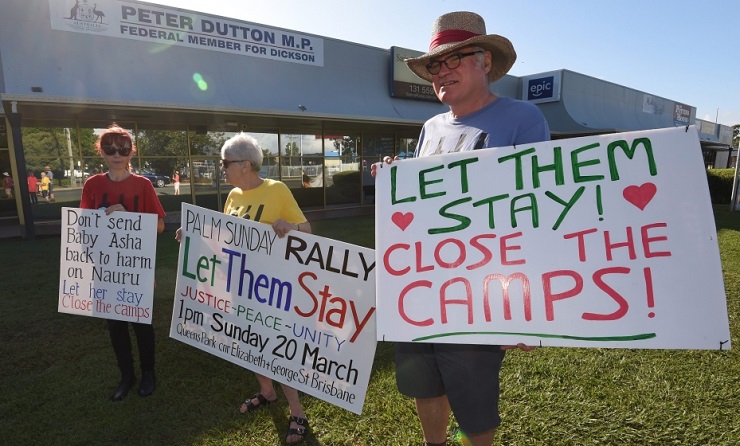One of the great ironies is of modern Australian life is attitudes to migrants, specifically, those who come to the country or attempt to do so as refugees. The first white settlers arrived 250 years ago, consisting of English prisoners, and their guards. They found a country occupied by an aboriginal people who had been there for more than 100,000 years. The British settlers disregarded the rights of the indigenous people.
They did more than that. They actively opposed their rights to the land they had long occupied. When the indigenous people objected and tried to oppose the theft of their land they were hunted and killed. There was a similar uneerie history in the United States where the white settlers moved west from the original 13 colonies. The indigenous Indian population was reduced from around 7 million in the 18th century to barely 100,000 by the turn of the 20th century. It was one of the greatest genocides perpetrated on an indigenous population in the whole of human history.
The slaughter of the aboriginal population of Australia was less severe than that of their American Indian counterparts, but it was nonetheless devastating. The policy of land theft was also identical. All arable land was simply taken and converted to white settler’s farms.
Australia is a very large country and needed settlers. Initially they were drawn almost exclusively from British stock, but after World War II the pool was expanded to include settlers from Europe. A very large number of Italians and Greeks came to Australia after the end of the war.
Despite its location as a continent on the southern fringe of Asia, Australia has never looked to Asia as a major source of migration. Although there are now more than 1 million people of Chinese extraction living in the country (about 4% of the total) they have suffered discrimination and prejudice. This has exacerbated in recent years as trade relations between Australia and China (its largest market by a significant margin) have deteriorated.
A bilateral feature of Australian population policy has been a distrust of political refugees from the Middle East. The irony that Australian foreign policy has been not the least of the “push” factors from the Middle East is completely lost upon the Australian political class.
It has been a bipartisan response that refugees from that part of the world are not welcome. It was equally a bipartisan approach to prevent such refugees from ever entering into Australia. To this end, the government set up offshore detention camps, numbering at their peak thousands of refugees. The island of Nauru is one such dumping ground. There are currently 900 people held on Nauru under appalling conditions, including 109 children.
The children have repeatedly attempted suicide and there are reliable reports of an increasing number becoming catatonic. There have also been repeated reports to the Australian parliament, to the United Nations and to other international bodies about the conditions and treatment of the detainees. Those reports have all been ignored by the Australian government. The attitude taken by the Australian government is that these persons, subject as they are to appalling conditions that amount to cruel, inhumane and degrading conduct, need to be punished for the “crime” of seeking a better life for their children and themselves.
A measure of the hypocrisy of the government is that they refused an offer from New Zealand to take 150 of the refugees. The fear was that they would gain New Zealand citizenship and thereby be entitled to come to Australia to live and work. The absence of any rational basis for this belief has not been a deterrent.
Papua New Guinea has adopted a more humane policy. The Australian detention camps have been closed and the people allowed to live in the community. Papua New Guinea has offered them citizenship, although few have as yet accepted the offer.
The third detention centre is located on Christmas Island a tiny Australian position located south of Indonesia in the Pacific Ocean 3385 km from Australia. The detention centre there was closed in October 2018, but in February 2019 the Australian prime minister Scott Morrison announced plans to reopen the facility.
In August 2019 the Biloxla family, father, mother and two children now five years and three years old and both born in Australia, were moved there. The family had been living in a small Queensland town where they were welcomed by the local people. The family are the only migrants living on the island, at an annual cost to the Australian government of $1.4 million per annum.
Since then, despite both children having been born in Australia, the government has been trying to remove them back to Sri Lanka. On 16 February this year the government lost an appeal to the full Federal Court to remove them back to Sri Lanka. They remain on the island where the children are deprived of the company of other children. The political damage to these children of such inhumane treatment is difficult to gauge. It will certainly be considerable.
The government seems impervious to the damage it is doing, not only to the lives of the Biloxla children but to all persons caught by the rigid policy pursued not only by the government, but with the apparent support of the Opposition. The government is also impervious to the reputation of Australia in its disregard for multiple international bodies to which it professes adherence.
It is difficult to perceive any change in attitude being likely. Australia will continue its appalling treatment of persons who sought nothing more than the opportunity for a better life. History will not judge them kindly.
James O’Neill, an Australian-based former Barrister at Law, exclusively for the online magazine “New Eastern Outlook”.

